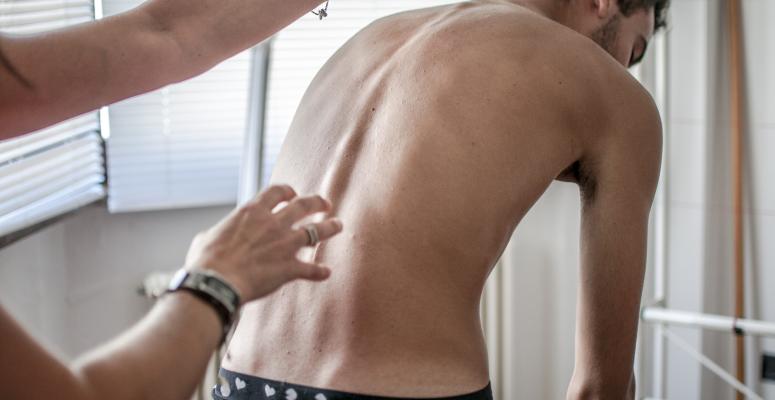
Scoliosis is a musculoskeletal condition defined by a sideways curvature in the spine. It can be quite painful for some people, leading to chronic pain and decreased mobility. If left untreated, it can also lead to respiratory problems like restrictive lung disease or even respiratory failure.
Unfortunately, it is a very common condition, affecting between 2% and 3% of the U.S. population. That’s between 6 and 9 million people.
There are treatment options, though, such as physical therapy. In this article, we’ll discuss exactly how physical therapy works for scoliosis and how it can help you manage the pain associated with this condition.
What kind of physical therapy is done for scoliosis?
Every physical therapy clinic offers different treatment options, and most therapists design a customized treatment plan for each patient. However, here are some physical therapy methods commonly found in scoliosis treatment plans:
- Education — One of the great things about seeking physical therapy for scoliosis treatment is that your therapist will help you understand what scoliosis is, why it occurs and how it affects the rest of your body. This will help you to understand the importance of your treatment plan so that you see it through to its completion.
- Posture analysis — Your physical therapist will analyze your posture and movement behaviors to identify any bad habits causing increased pain or worsening your scoliosis symptoms.
- Range-of-motion exercises — Scoliosis can limit your ability to move around comfortably, which can worsen pain and other symptoms. Your physical therapist will teach you exercises that can increase your range of motion so you have an easier time moving around.
- Strength training — Because scoliosis causes your spine to curve to one side, muscle imbalances can develop. Physical therapy can help you restore muscles on both sides of your spine.
- Manual therapy — Manual therapy is a treatment method in which the therapist manually manipulates your bones and soft tissue with their hands. This can temporarily relieve pain, allowing you to focus on treatment without discomfort.
- Joint mobilization — Joint mobilization is a form of manual therapy that focuses specifically on the joints. Your physical therapist will manipulate the joints in your spine to help relieve tension and restore your range of motion.
- Aquatic therapy — Aquatic therapy brings your treatment sessions into a swimming pool, which relieves some of the pressure placed on your back and can be effective for scoliosis treatment (along with various types of injuries).
How long does it take to treat scoliosis with physical therapy?
Every patient is different. Some patients will start to feel results after one to two months of attending physical therapy one or two times per week. Others may start to feel results sooner, or it may take longer. The exact timeline depends on the severity of a patient’s scoliosis symptoms.
Is physical therapy an alternative to scoliosis surgery?
Physical therapy can be an alternative to surgery for some patients. It can help strengthen core muscles, restore proper posture in the spine, and take pressure off the back muscles, all of which scoliosis surgery aims to do.
However, surgery may be necessary if the curvature of your spine is causing a blockage in your respiratory or digestive systems. You should discuss this with your doctors and physical therapists before deciding to pursue physical therapy as a scoliosis surgery alternative
Physical therapy exercises for scoliosis
Exercise is involved in most scoliosis physical therapy treatment plans. Here are a few exercises that your physical therapist may use for treatment:
- Abdominal presses — Lie on your back with your feet flat on the floor and your knees bent. Bring both of your thighs upward toward your body, bending your knees simultaneously until they are parallel with the floor. Reverse this motion until your legs are back on the floor. Pause for three seconds and repeat 10 times.
- Arm and leg raises — Lie with the front of your body and forehead on the floor. Extend your arms outward on the floor in front of you. Raise all of your limbs off the floor, hold for five seconds, and lower them. Repeat 15 times.
- Pelvic tilts — Lie on your back with your feet flat on the floor and your knees bent. Push your lower back off the floor while tightening your abdominal muscles. Hold for five seconds; then release. Repeat 10 times.
Note: It’s always best to consult a professional before performing any physical therapy exercises. They’ll be able to determine whether certain exercises are unsafe for your particular condition. They will also recommend additional exercises or alternatives that may work better for you.
Alliance PTP is ready to help you find top-notch physical therapy for scoliosis
At Alliance Physical Therapy Partners, we’re proudly bringing together physical therapy practices across the country to help people get the high-quality PT they need. Want to see a physical therapist in person? We can put you in touch with an Alliance PTP partner that’s close to you and that can help you address scoliosis.
Not keen on in-person PT sessions or not close to an Alliance PTP partner? No worries. We also offer effective and affordable virtual physical therapy through our Agile Virtual Physical Therapy platform.
Contact our team today so we can help you find the most effective physical therapy services for your injury or condition
Get Help at a Location Near You
